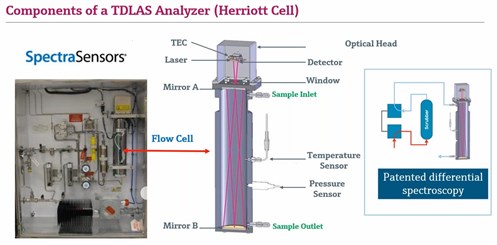SOGAT 2020: Ensuring efficiency, safety in gas sweetening with reliable measurement
By Adrienne Blume, Editor-in-Chief, Gas Processing & LNG and Executive Editor, Hydrocarbon Processing
The SOGAT (Sour Oil & Gas Advanced Technology) annual conference took place virtually this year on September 28–30. On the afternoon of Day 1, Prasanth Sreekumar, Global Industry Development Manager for Gas at Endress+Hauser, explained how to improve the efficiency of gas sweetening units by taking advantage of technologies that offer the highest levels of process and functional safety.
Process variables affecting the safety and efficiency of gas processing units include inlet gas pressure, temperature and flowrate, as well as inlet amine temperature, circulation rate and concentration. Each of these parameters must be measured to ensure that the process is operating correctly and reliably.
Gas flow/quality measurement challenges. To measure gas flow, a number of parameters must be taken into account including the varying composition of feed gas, wet gas conditions, efficiency loss and adsorption of acid gases due to flowrates being below specified limits. Furthermore, high gas flowrates in the contactor can result in foaming, amine carryover and reboiler overload.
Gas quality measurement, meanwhile, is complicated by stream composition variation, wet gas conditions and amine carryover. The challenge is to reliably measure CO2 and trace H2S with a single, reliable technology.
Tunable diode laser absorption spectroscopy (TDLAS) technology (see image) offers high speed of response, factory calibration with a simulated process stream, robust measurement with minimum maintenance, and detection of low-ppm traces of hydrogen sulfide (H2S).

O2 and level measurement. Oxygen (O2) measurement, which is used in select gas processing operations, helps prevent corrosion of equipment, keeps pipeline O2 levels accurate and prevents the formation of elemental sulfur. To detect O2 levels in a gas pipeline, quenched fluorescence technology is often used. Quenched fluorescence is not affected by H2S and can work under wet gas conditions.
Level measurement for the contactor and stripper can be guaranteed with guided wave radar technology. Level transmitters help maintain process efficiency and help minimize problems associated with reboiler overload and chemical losses. They also aid in foam detecting and interface measurement in the flash tank.
Amine circulation issues. Amine circulation is important to measure because excessive circulation rates can result in serious problems, such as increased fuel consumption, exceeded reboiler capacity, increased amine losses, increased corrosion rates and greater pump maintenance. Coriolis flowmeters are the measurement device of choice here, explained Mr. Sreekumar. These flowmeters feature the highest process safety, multivariable measurement (flow, density, temperature, etc.), high process performance for liquids and gases, and integrated verification—i.e., Endress+Hauser's Heartbeat technology.
Endress+Hauser provides a complete field instrumentation portfolio to support the efficient and safe operation of natural gas processing. Its TDLAS technology offers unique benefits in measuring CO2 and trace levels of moisture and H2S. Its ultrasonic process gas flowmeter offers a unique solution for wet gas measurement, and the benefits of its Heartbeat technology are unmatched in the process industry.
SOGAT on demand! If you missed any of the virtual presentations from this year's SOGAT conference, you can access them on demand at http://sogat.nowvirtual.live, using your username and password.

- ExxonMobil halts 1-Bft3d blue hydrogen project in Texas
- Aramco and Yokogawa commission multiple autonomous control AI agents at Fadhili gas plant
- Ukraine will resume gas imports via Transbalkan route in November
- Mitsubishi to inject $260 MM into Brunei LNG project
- Freeport LNG (U.S.) on track to take in more natgas on Thursday after unit outage



Comments